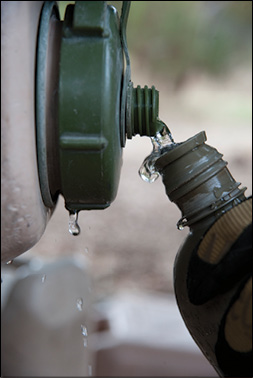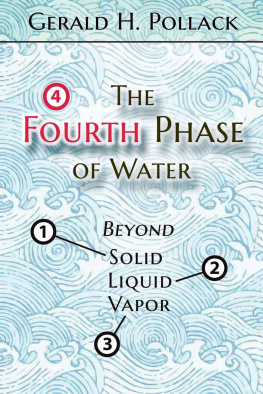The U.S. Navy SEAL
Guide to
Water Secrets
Learn the survival techniques and
strategies of americas
elite warriors
Don Mann
and Ralph Pezzullo
Skyhorse Publishing



 Pond
Pond
Getting lost or stranded in the wild is something that can happen to anyone, whether youre a Navy SEAL, experienced outdoorsmen, hiker, tourist, or just someone out for a weekend drive. Anybody can be forced to deal with circumstances beyond their control, alone and lost, with only their wits to rely on for survival.
The human body is composed of up to seventy-eight percent water. So its no surprise that the single-most important thing you need to live is not food; its water. The good news is that if youre resourceful and know where to look, you can find or collect good drinking water in just about any environment on earth.
The Institute of Medicine currently recommends a daily intake of approximately 2 to 2 quarts of water to replace the water lost through normal body functionsurination, defecation, breathing, and sweating. All of the chemical and electrical activities that take place in the human body take place in a water environment; when water is in short supply, these activities begin to malfunction.
Its important to understand that many people begin their survival already dehydrated due to stress and other factors. They often continue to dehydrate further when water supplies are limited and the quality of any available water is suspect. People needing water, but fearful that it is contaminated with Giardia, Cryptosporidium, or other harmful pathogens, often put off drinking or choose not to use the water at all.
In North America, as a general rule, it is better to drink available fresh water.
If the water contains harmful pathogens, the onset of symptoms will usually be days, if not weeks away. By then the individual will hopefully have access to medical care.
The one exception to this rule is that certain lakes mainly found in the western United States contain high concentrations of calcium carbonate and calcium bicarbonate. This water is not potable. Lakes containing these substances are usually easy to identify because the calcium salts leached from the soil are deposited in the form of white powder around the shorelines. This water tastes terrible and should not be consumed unless there is absolutely no other water source available.
In other parts of the world, especially developing countries, drinking water that has not been disinfected is NOT recommended.
Viruses such as hepatitis, not commonly found in North American waters, are prevalent here and can quickly cause incapacitating illness.
Finding Water
Throughout much of North America, fresh water can usually be found in open sources such as lakes, ponds, rivers, and streams. In most cases, it can be obtained fairly easily. Remember that water always seeks the lowest level possible and that, if present, some form of vegetation will most likely grow nearby.
The best way to locate water is from a vantage point that allows you to scan the surrounding countryside. Slowly and methodically look for indicators such as green vegetation, flocks of birds, trails left by domestic and wild animals, and even large formations of rock that can contain natural springs. Check for low-lying areassuch as depressions or sinkswhere rainfall or melting snow is likely to collect. Water can often be found in these areas long after the last precipitation, especially if they are shaded.
Water sources like these should be checked carefully since theyre often contaminated with debris that has been washed into the drainage. Finding the remains of animals that have died nearby or in the water and other similar contaminants will necessitate boiling the water, the use of halogens (iodine or chlorine), or the use of a mechanical purification pump.
The quantity of water produced by seeps and springs tends to vary greatly. Some of them produce no more than a few teaspoons of water per hour. In other cases, gallons of water can flow from the ground in minutes. Where the output is slow and small, use the flat edge of the mouth on a plastic bag to scoop up the water from a shallow source; if it is flowing, use it to collect the water as it runs into the bag. A short piece of vinyl aquarium hose also works well for sucking up water from shallow collections or to recover water from narrow cracks in the rocks.
Also, keep an eye out for man-made sources of water such as windmills, wells, tanks, dams, and irrigation canals. Windmills are common in parts of North America, especially in areas where little surface water exists. In most cases, the water pumped to the surface is collected in a nearby tank or pumped directly into a trough from which livestock can drink. Where an open source is not available, it may be necessary to dismantle the piping associated with the windmill to gain access to the water.
If you find an abandoned well where the rope and bucket typically used to lift water from these wells is missing, improvise a means to lower a container down into the well to retrieve the water. If you dont have a container, an item of clothing can be lowered into the water to serve as a sponge.
In arid areas, particularly in the western and southwestern United States, many state wildlife agencies and conservation organizations have installed rainwater collectors called guzzlers. These are designed to gather precipitation and feed it into a holding tank, where it remains until it is either consumed by animals or evaporates.
Just because theres no water visible on the surface of the ground, that doesnt mean that its not present in the soil in sufficient quantity to be collected. Locate low-lying areas where water is most likely to have accumulated and dig down until damp layers of soil are found. The hole should be about a foot in diameter. Over time, water may seep into the hole where it can be collected. If no indicators of subsurface water are present, dig a hole in the outside bend of a dry riverbed. Look for a location where the centrifugal force of flowing water has eroded the outer bend, creating a depression where the last remnants of water flowing downriver will have accumulated.
Groundwater collected this way is likely to be muddy, but straining it through cloth will clean it and will get you by in the short term. Its important to remember that youre taking a risk anytime you drink ground water without purifying it.
Rain is a great source of drinking water and in most rural areas can be consumed without risk of disease or illness. If you have a poncho or some plastic sheeting, spread it out and tie the corners to trees a few feet off the ground. Find a container and tie the plastic on a slant so that the rainwater can drain into it. If you cant find a container, devise a makeshift water bag by tying the plastic level on all four corners but letting it sag in the middle so that the rainwater can collect there. If the rainwater tastes different than what youre used to, its because it lacks the minerals that are found in groundwater and in streams. If you dont have a poncho, rain gear, or piece of plastic, remember that water will collect on the upper surfaces of any material (it doesnt have to be waterproof) and drain to the lowest point, where it can be collected in a bucket or other container.











 Pond
Pond